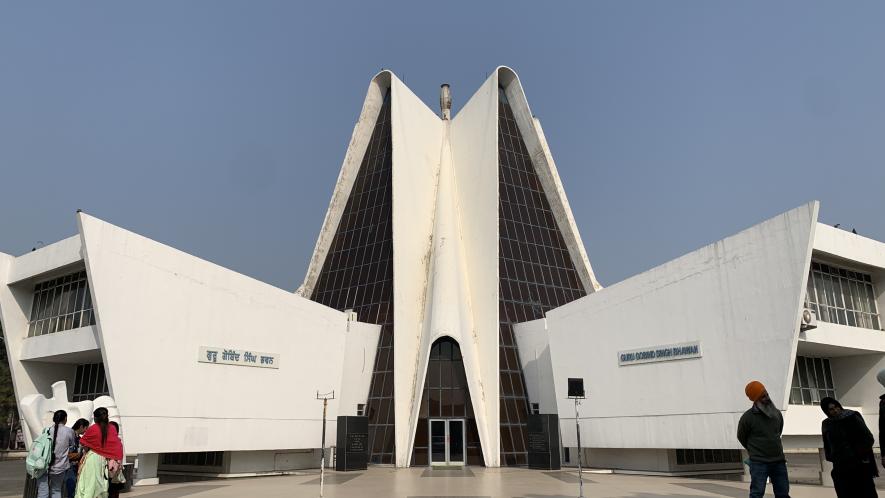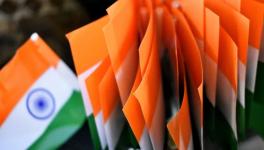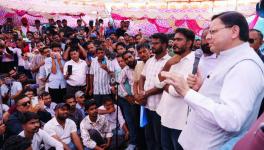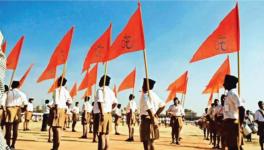Punjab Elections: State Universities Crumbling as Political Parties Look Away

As the sun sets, the tranquil campus of Punjabi University in Patiala is abuzz with the discussion around the scheduled visit of chief ministerial candidate of Aam Aadmi Party Bhagwant Mann in nearby Urban Estate market as well as the lush green campus. Mann, a two-time member of parliament, is on entourage throughout the state to seek support for his party’s candidates. Contrary to the expectations of students, Mann spoke for 3 minutes and did not speak about the sad state of affairs at state-funded universities. The state, laden under the debt of Rs 3 lakh crore, is battling to fund state universities as the institutions repeatedly approached banks for loans to pay salaries. Congress and Akali Dal have not so far released their manifesto.
To begin with, Punjab hosts nine state universities and 47 government colleges. However, Punjabi University (Patiala), Punjab University (Chandigarh), Guru Nanak Dev University (Amritsar) and Punjab Agricultural University (Ludhiana) remain the major centres of learning and attract the highest number of students. Even though universities carry out academic activities, they find it increasingly difficult to run operations as the Punjab government struggles to fund these institutions. The students of Punjabi University Patiala protested against a fee hike in November last year when the administration could no longer bear the burden of a Rs 150 crore loan.
Amidst paltry grants, the university requested the Punjab government to waive off the Rs 150 crore loan because it paid a huge interest of Rs 16 crore per year and increased the monthly grant to Rs 20 crore to pay the salaries of the employees. The university has also pledged the bank the properties worth Rs 30 crore. Even as the students maintain that the institution is engaged in groundbreaking scientific research and contributing to preserving the state's culture, the academic activities are hit as the university struggles to procure books, journals, chemicals, and consumables.
Varinder Khurana, a PhD student at the Department of Punjabi told NewsClick that even though the Malwa belt remains the biggest region of Punjab, the state of higher education institutions witnessed consistent negligence through non-funding and disinterest. He said that the crisis in higher education gets reflected when the Punjab government fails to maintain a constant flow of funds to the Punjabi University even when they know that the institution does not only cater to the highest number of students but also marginalised sections of society. “There are no funds. When there are no funds, how do we have new books and journals? The infrastructure is crumbling. Few departments are entirely dedicated to research. How do these departments justify their existence now?”
Paramjit Kaur, a PhD student researching education, put the crisis about the mandate of educational institutions. “The mandate of various government schemes was to bring the students of marginalised sections to these institutions to educate them. When a government does not fund an institution, it does exactly the opposite of it. I fail to understand if governments are allowing corporates to run not only banks but forego their loans even when they are very much capable of repayment, why cannot they do it with educational institutions!”
Balwinder Singh Tiwana, retired professor of Economics from Punjabi University, told NewsClick that the fund crisis was visible across the state where the teachers of government colleges had to come on the streets for their salaries. The state of affairs was so worse, he claimed, that the Baba Hira Singh Bhattal Institute of Engineering and Technology staff run under the patronage of former CM RK Bhattal had not paid salaries for months now.
“As far as Punjabi University is concerned, we see a consistently diminishing number of teachers in the absence of new recruitment, because the government did not pay university enough funds. We have a few departments, including Botany, Physics, Chemistry, and Economics, where teachers' strength reduced to one third. Research scholars are now supplementing the work of teachers. The university witnessed consistent cuts in funds from 1991 onwards. In 1991, the university's budget was about Rs 18 crore in which Rs 12.10 crore was allocated for paying salaries, and Rs 1.69 crore was received as a fee from students. The Punjab government gave Rs 15.15 crore, well above the salaries bill. By 2004, the situation changed and 60% of the budget came from students’ fee. Currently, the government gives Rs 114 crores per annum, whereas the contribution received from the students' fee is Rs 217 crore per annum. CM Channi came to campus and announced that he will forego the loan of Rs 150 crore. Until code of conduct came into force, the university did not get any funds.”
Arvind, Vice-Chancellor, Punjabi University told NewsClick that it is possible to recover from the situation and that the university would carry forward academic and research activities. Arvind, who assumed charge of the university in April 2021, said that the university has some unique features and if adequately tapped, it could emerge as one of the centres of excellence in research and learning, provided the government funds flow is consistent.
He said that the university caters to the students of the Malwa belt, the biggest region in the state. “The university has made some outstanding contributions to research in Punjabi literature, including Oral History Archive and also stores a very rare collection of books. Given the presence of a large Punjabi diaspora worldwide, it can attract much support. The university also caters to a large number of students from marginalised sections. If given adequate support and care, we can do wonders.”
Arvind added that “When I joined the university, it was in a messy situation. The previous vice-chancellor had resigned, and an interim IAS VC was appointed. During her tenure, all deans and the registrar had resigned. Salaries hand not been paid for months. The university had a Rs 150 crore overdraft and pending payments worth Rs 100 crore. There were pending enquiries and corruption charges. Now, I do not come from a state university background. I am a scientist who first worked at IIT Madras, then at IISER Mohali. My friends told me about the situation at Punjabi University Patiala and emphasised that the people of Punjab should get involved in the solutions of the state's problems. So, it inspired me to come to Punjabi University and resolve the crisis.”
“When I observed the situation, I found that we could recover. After analysing the issues, I convinced the government that it should forego the loan of Rs 150 crore because we were paying huge interest on it. Secondly, the government should give us Rs 20 crore as a monthly grant because we need to pay Rs 30 crore per month as salary and we cannot generate this much revenue. If we do not have funds, we cannot update our technology, we cannot buy enough journals, consumables and chemicals and fulfil research and teaching needs.
“I would also like to emphasise that not all problems need money for their solution. The university needed administrative and academic reforms. We are in the process of implementing these reforms. There may be an administrative crisis, but there should not be an academic crisis. On the fee front, we did revise the fee because it had not been increased for a very long time. But again, the government wanted me to bring the fee at par with Guru Nanak Dev University Amritsar and Punjab Agricultural University (PAU) Ludhiana. I emphasised that doing this would be setting a wrong precedent. I hence decided that I would be revising the fee in proportion with the previous fee structure and not in competition with other universities. The intrinsic character of the university's contributions of providing low-cost, high-quality education to marginalised and needy students will not be changed by this revision in the fees, and the university is not looking for a solution to the financial crisis by increasing student fees.”
However, the situation takes a different turn at Guru Nanak Dev University in Amritsar, where teachers maintain that sustainability came through a consistent increase in fee and non-recruitment of teachers. SS Dhillon, retired professor of Economics and former registrar of the university, said that the impact of debt could be felt through the non-recruitment of teachers in government colleges. The state has only 330 professors against the sanctioned strength of 1,873 posts.
Talking to NewsClick, Dhillon said that the political parties are talking about freebies only because they do not wish to discuss the crisis. “When there is a huge debt, and you are paying an enormous amount of money as interest, there is no capital investment. This is why we see no recruitment in primary, secondary and higher education. If we are a welfare state, why should political parties talk in this tone of providing free things? In universities, you are consistently pressurising the VCs to arrange funds independently. How would they arrange it if the government does not give them the grant?”
Amarjit Singh Sidhu, professor at University Business School at GNDU, said that the reckless increase in fees had compelled the parents of students to pay the fee by mortgaging their jewellery. He said, “I met the parents of a student who came to me for some relaxation in fee because they were finding it hard to fund the studies. They had already mortgaged their jewellery. I was aghast. This is not how a university funded by the state government is not run. The overall feel of the MBA programme at the university is Rs 2 lakh. How would common persons fund the studies of their children?”
Sidhu maintained that the university was facing a crunch of teachers where assistant professors were made to handle as many as 8 PhD researchers. Contract teachers constitute 40% of the teaching workforce now. He said, “The travesty is such that the history department which produced historians like JS Grewal was being looked after by a professor of the school of sciences because the department did not have a professor now.”
Get the latest reports & analysis with people's perspective on Protests, movements & deep analytical videos, discussions of the current affairs in your Telegram app. Subscribe to NewsClick's Telegram channel & get Real-Time updates on stories, as they get published on our website.
























